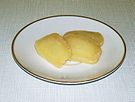
Pierogi are filled dumplings made by wrapping unleavened dough around a savory or sweet filling and cooking in boiling water.

Cedynia is a small historic town in Poland, and the administrative seat of Gmina Cedynia in Gryfino County, West Pomeranian Voivodeship. It is situated close to the Oder river and the border with Germany. The town is known for the 972 Battle of Cedynia, the first historically recorded battle of Poland.
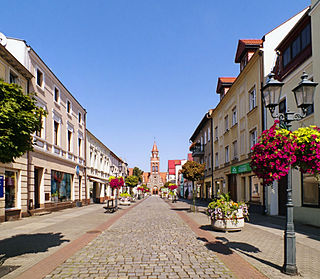
Grodzisk Wielkopolski is a town in western Poland, in Greater Poland Voivodeship (Wielkopolskie), with a population of 13,703 (2006). It is 43 kilometres (27 mi) south-west of Poznań, the voivodeship capital. It is the seat of Grodzisk Wielkopolski County, and also of the smaller administrative district called Gmina Grodzisk Wielkopolski. The suffix "Wielkopolski" distinguishes it from the town of Grodzisk Mazowiecki in east-central Poland.
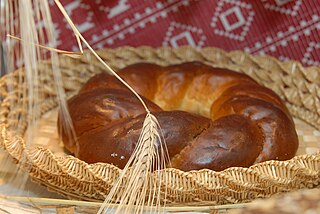
Kolach or kalach is a traditional bread found in Central and Eastern European cuisines, commonly served during various ritual meals. The name originates from the Old Slavonic word kolo (коло) meaning "circle" or "wheel". Korovai is sometimes categorised as a type of kolach.

Ostrzeszów is a town in central Poland, in Greater Poland Voivodeship. It is the capital of Ostrzeszów County. The population in 2006 was 14,536 inhabitants. The town is situated around 80 kilometres from Wrocław, 170 km from Katowice and 160 km from Poznań.

Niemcza is a town in Dzierżoniów County, Lower Silesian Voivodeship, in south-western Poland. It is the seat of the administrative district (gmina) called Gmina Niemcza.

Zwoleń County is a unit of territorial administration and local government (powiat) in Masovian Voivodeship, east-central Poland. It came into being on January 1, 1999, as a result of the Polish local government reforms passed in 1998. Its administrative seat and only town is Zwoleń, which lies 104 kilometres (65 mi) south-east of Warsaw.
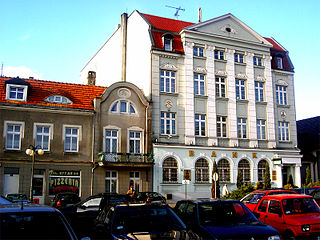
Witkowo (; is a town in Gniezno County, Greater Poland Voivodeship, Poland, located southeast of Poznań.

Poręba is a town in Zawiercie County, Silesian Voivodeship, Poland, with 8,525 inhabitants (2019). The town has the area of 40 km2 (15 sq mi), and lies along National Road Nr. 78; it also has a rail station on a line from Miasteczko Śląskie to Zawiercie. Almost half of Poręba's area (49%) is covered by forests.
Wołuszewo is a village in the administrative district of Gmina Aleksandrów Kujawski, within Aleksandrów County, Kuyavian-Pomeranian Voivodeship, in north-central Poland. It lies 5 kilometres (3 mi) north-east of Aleksandrów Kujawski and 18 km (11 mi) south-east of Toruń. It is located in the historic region of Kuyavia.

Obwarzanek, or sometimes obarzanek, is a kind of Polish bagel. The name derives from the processing step obwarzanie (parboiling), or dipping in the boiling water. A Russian cognate is baranka.

Ruchanki is a flat, oval racuszki from bread dough or sponge cake, hot fried on fat.

Pampuchy are a type of steamed yeast dumpling (kluski) or doughnut (pączek) in Polish cuisine. A cooked pampuch (sing.) has an oval, flat on the bottom shape, with a bouncy, mushy and soft consistency. Pampuchy or bułki na parze are served hot: either sweet or savoury.
Opole cuisine is an umbrella term for all dishes with a specific regional identity belonging to the region of Opole. It is a subtype of Polish and German cuisine with many similarities to and signs of the influence of neighbouring cuisines.
Podlaskie cuisine is an umbrella term for all dishes with a specific regional identity belonging to the region of Podlaskie. It is a subtype of Polish, Lithuanian and Belarusian cuisine with many similarities to and signs of the influence of neighbouring cuisines.
Lublin cuisine is an umbrella term for all dishes with a specific regional identity belonging to the region of Lublin. It is a subtype of Polish and Galician cuisine with many similarities to and signs of the influence of neighbouring cuisines.
Świętokrzyskie cuisine is an umbrella term for all dishes with a specific regional identity belonging to the region of Świętokrzyskie. It is a subtype of Polish and Galician cuisine with many similarities to and signs of the influence of neighbouring cuisines.
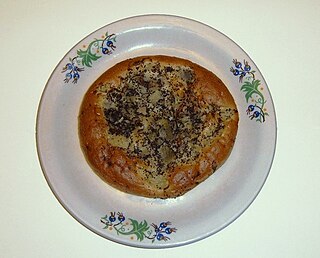
Cebularz is a wheat dough pancake in Polish and Ashkenazi Jewish cuisine, with a diameter of 15-20 cm, topped with diced onion and poppy seed (15-20%), characteristic for Lublin cuisine.



